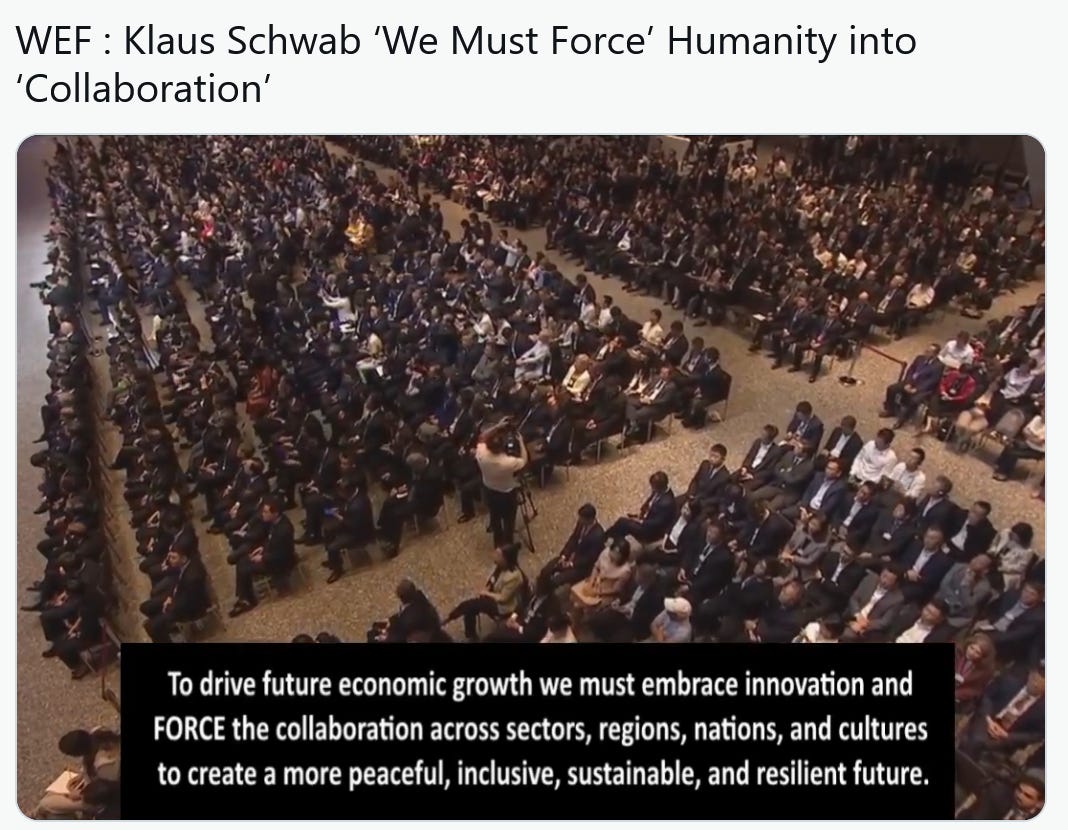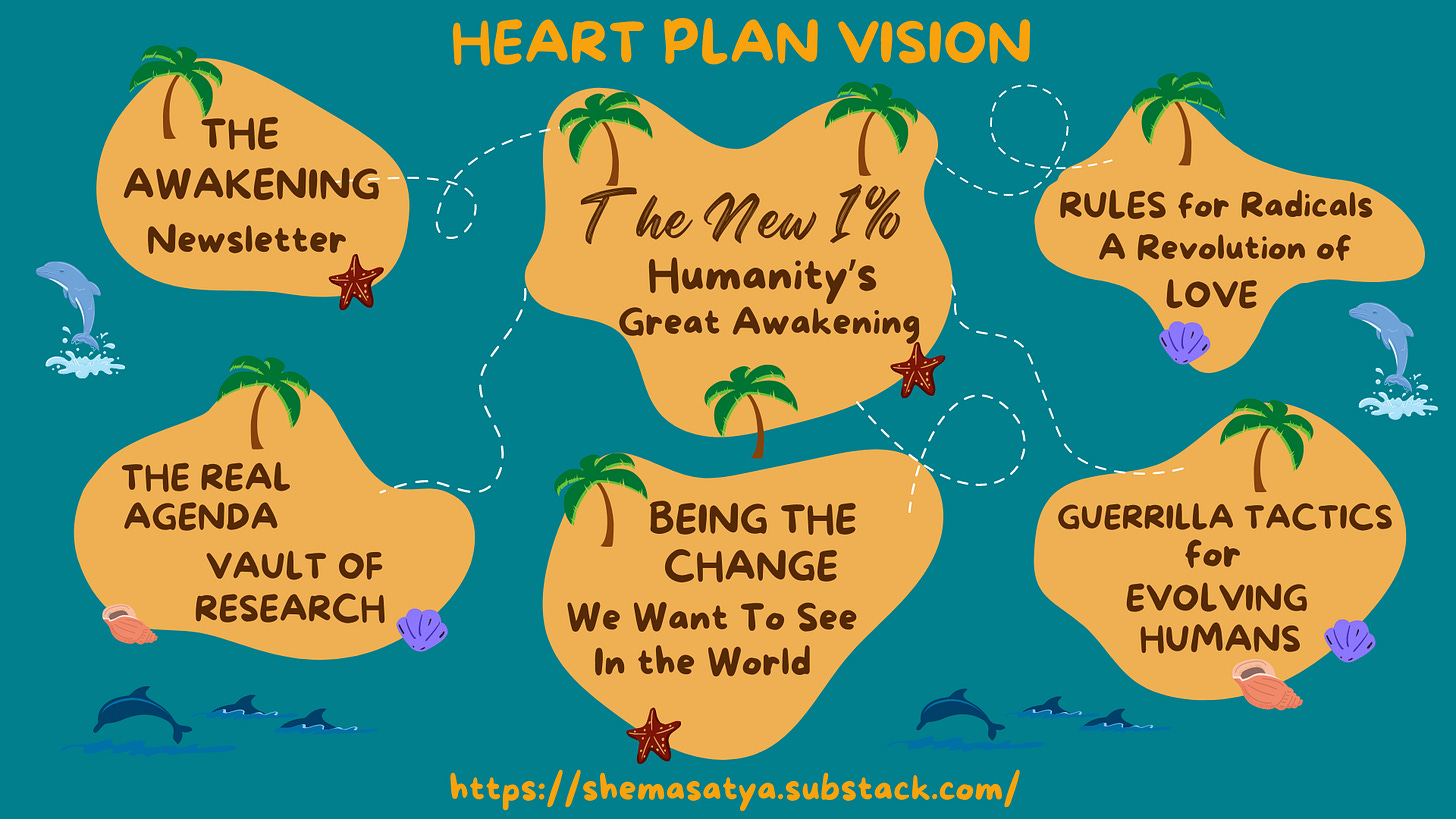A Grassroots Response - Imagine - to Schwab's "We Must Force Collaboration"
Exploring Endless Possibilities for Engaged and Voluntary Collaboration
We can counter the narrative of forced collaboration and demonstrate that true progress comes from voluntary, ethical, and inclusive cooperation.
What follows are a collection of statements from Klaus Schwab (World Economic Forum - an unelected global group).
And then, what might be called a Global Elite Resistance Guide,
or even better
A Humanity Freedom Empowerment - Ideas ‘Brainstorm of Possibilities’
———————————————
🌟 Watch: Klaus Schwab Says Humanity Must Be ‘Forced Into Collaboration’ With Globalist Elites
🌟 Klaus Schwab: ‘We Must Force Humanity Into Collaboration’
World Economic Forum founder and director Klaus Schwab, speaking at the WEF’s recently concluded summer meeting in China, has informed his elitist followers that ushering in the globalist agenda will require humanity to be “forced” into a “collaboration” with the unelected organization. And the time for forced collaboration has now arrived.
This is why Schwab told his globalist comrades at a previous meeting over two years ago to expect an “angrier world.”
When you force people to live in ways that controvert their best interests, it tends to make them angry!
They know their policies related to a green economy, perpetual wars and severe restrictions on food production will be extremely unpopular and cause civil wars on top of the world war they already have planned.
———————————————
🌟 FLASHBACK: Klaus Schwab Excitedly Said Elections Won’t Be Needed Soon
“But since the next step could be to go into prescriptive mode, which means you do not even have to have elections anymore because you can already predict what, predict, and afterwards you can say, ‘Why do we need the elections?’ Because we know what the result will be. Can you imagine such a world?”
— Klaus Schwab
———————————————
🌟 Now Let’s Switch Focus to Idea Generate
A Humanity Freedom Empowerment - Ideas ‘Brainstorm of Possibilities’
How do people stand up to the global elite? Exploring empowering questions and action items everyday people can take to stop this global domination, in particular to address the WEF group itself.
Idea Generating Topics Covered
10 Empowering Questions
10 Action Items
Three Most Impactful Actions to Do Immediately
Immediate Steps to Take
10 Ways to Build Momentum for Community Building Success
Building Momentum Strategies
Developing Core Values for a Grassroots Empowerment Movement
Examples of Core Values for a Grassroots Empowerment Movement
10 Ideas to Address the ‘Forced Collaboration’ Aspect of Klaus Schwab's Speech
Implementation Steps for Engaged and Voluntary Collaboration
Bringing These Ideas into School Classrooms
Implementation Steps for School Classrooms
10 Most Impactful Actions to Inspire Action
Designing Next Steps
Writing an Article and Making It Viral
Questions to Stimulate Ideas to Go from Idea to Action
Keywords and Tags
———————————————
✳ 10 Empowering Questions
What personal values are most important to me, and how can I align my actions with these values to resist globalist agendas?
How can I educate myself and others about the true intentions behind the policies promoted by organizations like the WEF?
What local community initiatives can I support or create to foster self-sufficiency and resilience against centralized control?
How can I use my skills and talents to contribute to a grassroots movement that promotes individual sovereignty and freedom?
What steps can I take to reduce my reliance on systems and technologies that are controlled by global elites?
How can I effectively communicate the importance of personal freedom and sovereignty to my family, friends, and community?
What are the potential vulnerabilities in the global elite’s plans, and how can we exploit them to protect our rights and freedoms?
How can we create and support alternative economic systems that are independent of centralized financial control?
What historical examples of successful resistance movements can we study and learn from to inspire our efforts today?
How can I collaborate with like-minded individuals and organizations to build a powerful network of resistance and empowerment?
———————————————
✳ 10 Action Items
Educate Yourself and Others:
Regularly read and share information from credible sources about the globalist agenda and its impact on individual freedoms.
Organize community discussions or book clubs focused on sovereignty and empowerment.
Support Local Economies:
Buy from local farmers, artisans, and small businesses to reduce dependence on global supply chains.
Promote and participate in local barter systems and community-supported agriculture (CSA) programs.
Build Self-Sufficiency:
Learn and teach essential skills such as gardening, food preservation, and basic repairs.
Install renewable energy systems like solar panels to reduce reliance on centralized power grids.
Engage in Civil Activism:
Attend town hall meetings, join local activist groups, and participate in peaceful protests.
Contact your elected representatives to express your concerns about policies that threaten personal freedoms.
Form Community Alliances:
Network with other grassroots organizations to share resources, strategies, and support.
Create a community resilience plan that includes mutual aid networks and emergency preparedness.
Promote Digital Privacy:
Use encrypted communication tools and advocate for digital rights and privacy.
Educate others about the importance of digital security and how to protect personal information online.
Create Independent Media:
Start a blog, podcast, or YouTube channel to spread awareness and counter mainstream narratives.
Support independent journalists and alternative media outlets that align with your values.
Encourage Political Accountability:
Hold local and national leaders accountable by demanding transparency and integrity.
Support candidates and policies that prioritize individual rights and decentralized governance.
Foster a Culture of Critical Thinking:
Encourage critical thinking and skepticism in your community, especially regarding media and political messaging.
Promote educational programs that emphasize logic, ethics, and independent research.
Develop Alternative Systems:
Support the development and use of alternative currencies like cryptocurrencies that operate outside of centralized control.
Promote and participate in cooperative ventures, such as community banks and credit unions, that are owned and managed by their members.
Standing up to the global elite requires
A multi-faceted approach that combines education, local action, and community solidarity. By asking the right questions and taking concrete steps, we can build a resilient and empowered society that values individual freedom and collective well-being. Remember, every small action contributes to the larger movement towards a more just and sovereign world.
———————————————
✳ Three Most Impactful Actions to Do Immediately
Educate Yourself and Others:
Why: Knowledge is power. By understanding the globalist agenda and its implications, you can make informed decisions and inspire others to do the same.
How:
Regularly read and share information from credible sources about the globalist agenda and its impact on individual freedoms.
Organize community discussions or book clubs focused on sovereignty and empowerment.
Use social media platforms to disseminate well-researched articles and videos that expose the intentions of the WEF and similar organizations.
Support Local Economies:
Why: Strengthening local economies reduces dependence on global supply chains and promotes community resilience. It also diminishes the power that large multinational corporations and centralized entities have over our daily lives.
How:
Buy from local farmers, artisans, and small businesses to support your community.
Promote and participate in local barter systems and community-supported agriculture (CSA) programs.
Organize local markets and fairs to connect community members with local producers and service providers.
Engage in Civil Activism:
Why: Collective action amplifies individual voices, making it harder for policymakers to ignore the demands of the people. Engaging in civil activism helps build a sense of community and shared purpose.
How:
Attend town hall meetings, join local activist groups, and participate in peaceful protests.
Contact your elected representatives to express your concerns about policies that threaten personal freedoms.
Use petitions and social media campaigns to raise awareness and put pressure on decision-makers to consider the interests of their constituents.
———————————————
✳ Immediate Steps to Take
Start a Community Discussion Group:
Set up a regular meeting time and invite friends, family, and neighbors to join discussions about personal freedom, sovereignty, and the globalist agenda.
Share articles, documentaries, and books that provide insights into the issues at hand.
Shift Your Spending to Local Businesses:
Make a conscious effort to buy groceries, clothes, and other essentials from local vendors.
Encourage others in your community to do the same by highlighting the benefits of supporting local economies.
Join or Organize a Local Activist Group:
Find existing groups that align with your values or start your own.
Plan and participate in events that raise awareness and encourage civic engagement, such as town hall meetings, peaceful protests, and social media campaigns.
By focusing on these three actions, you can create a ripple effect that empowers individuals, strengthens communities, and challenges the dominance of the global elite.
———————————————
✳ 10 Ways to Build Momentum for Community Building Success
Identify and Engage Local Leaders:
Action: Reach out to respected individuals in your community, such as teachers, business owners, and activists, to join and support your cause.
Impact: These leaders can lend credibility and attract others to join the movement, amplifying your reach and influence.
Host Regular Events and Meetups:
Action: Organize regular gatherings, such as discussion groups, workshops, and social events, to build a sense of community and shared purpose.
Impact: Regular events create a routine and sense of belonging, encouraging continuous participation and engagement.
Leverage Social Media and Online Platforms:
Action: Use social media to create groups, pages, and events that promote your community activities. Share updates, success stories, and upcoming events to keep the momentum going.
Impact: Online platforms can significantly expand your reach, connecting you with a wider audience and facilitating communication and organization.
Create and Distribute Informational Materials:
Action: Develop flyers, brochures, and digital content that explain your mission, goals, and how others can get involved.
Impact: Informational materials help spread the word and provide clear, concise information to potential supporters.
Collaborate with Local Organizations:
Action: Partner with existing community groups, nonprofits, and businesses to co-host events and share resources.
Impact: Collaboration can increase your impact and visibility, as well as bring in new supporters from different networks.
Celebrate Successes and Milestones:
Action: Acknowledge and celebrate the achievements of your community, whether big or small, through events, social media posts, and newsletters.
Impact: Celebrating successes boosts morale, motivates participants, and showcases the positive impact of your efforts.
Offer Volunteer Opportunities:
Action: Provide various ways for people to get involved, from event planning to community outreach and advocacy.
Impact: Volunteer opportunities allow individuals to contribute their skills and feel invested in the community’s success.
Educate and Train Members:
Action: Host workshops and training sessions on relevant topics, such as grassroots organizing, communication skills, and local governance.
Impact: Education and training empower members with the knowledge and skills needed to effectively contribute to the movement.
Maintain Open and Transparent Communication:
Action: Keep the community informed about your activities, decisions, and progress through regular updates and open meetings.
Impact: Transparency builds trust and ensures that everyone feels included and valued.
Create a Strong Visual Identity:
Action: Develop a recognizable logo, color scheme, and branding for your community group. Use these consistently across all materials and platforms.
Impact: A strong visual identity helps create a cohesive and professional image, making it easier for people to recognize and connect with your movement.
———————————————
✳ Building Momentum Strategies
Kickoff Event:
Plan a well-publicized kickoff event to introduce the community to your mission and goals.
Use this event to gather contact information, distribute materials, and encourage immediate involvement.
Social Media Campaign:
Launch a targeted social media campaign to raise awareness and attract new members.
Share compelling stories, eye-catching visuals, and calls to action to engage your audience.
Monthly Challenges:
Introduce monthly challenges or themes that encourage community participation and interaction.
Examples include a local business patronage challenge, a neighborhood cleanup, or a volunteer drive.
Feedback Mechanisms:
Create channels for members to provide feedback and suggest ideas, such as surveys, suggestion boxes, or open forums.
Use this feedback to continually improve and adapt your initiatives.
Mentorship Programs:
Establish mentorship programs where experienced members guide and support newcomers.
This fosters a sense of community and helps new members feel welcomed and valued.
By implementing these strategies, you can create a vibrant and engaged community that is ready to stand together against globalist agendas and promote individual sovereignty and freedom.
———————————————
✳ Developing Core Values for a Grassroots Empowerment Movement
Conduct Community Workshops:
Action: Organize workshops where community members can discuss and identify shared values.
Impact: This inclusive approach ensures that the core values resonate with everyone and fosters a sense of ownership and commitment.
Survey Your Community:
Action: Distribute surveys (both online and offline) to gather input on what values are most important to the community.
Impact: Surveys provide a broad perspective and allow all voices to be heard, leading to a more comprehensive understanding of the community's priorities.
Facilitate Open Discussions:
Action: Hold regular open forums or town hall meetings where members can openly discuss and debate potential core values.
Impact: Open discussions encourage transparency and collective decision-making, ensuring that the values are reflective of the community's collective will.
Draft a Preliminary Set of Values:
Action: Based on the input gathered, draft a preliminary list of core values and present them to the community for feedback.
Impact: This iterative process allows for refinement and ensures that the final set of values accurately represents the community's consensus.
Align with Universal Principles:
Action: Ensure that the core values align with universal principles such as human rights, justice, and equality.
Impact: Aligning with universal principles gives the movement a strong ethical foundation and broader appeal.
Create a Core Values Committee:
Action: Form a committee of trusted and diverse community members to oversee the development and articulation of the core values.
Impact: A dedicated committee can provide focused attention and ensure that the process is thorough and inclusive.
Use Real-Life Examples:
Action: Identify and discuss real-life examples of individuals or actions that exemplify the proposed core values.
Impact: Concrete examples make the values more relatable and easier to understand and internalize.
Formalize and Document the Values:
Action: Once finalized, formally document the core values in a clear and accessible format, such as a values charter or manifesto.
Impact: A formal document serves as a reference point and guiding framework for the movement's actions and decisions.
Promote and Integrate the Values:
Action: Regularly promote the core values through all communication channels and integrate them into all activities and initiatives.
Impact: Consistent promotion and integration reinforce the values and ensure they are embedded in the movement's culture.
Review and Revise Periodically:
Action: Periodically review and, if necessary, revise the core values to reflect any changes in the community's needs or priorities.
Impact: Regular reviews ensure that the values remain relevant and responsive to the evolving context and challenges.
———————————————
✳ Examples of Core Values for a Grassroots Empowerment Movement
Freedom and Sovereignty:
We value the inherent freedom and sovereignty of every individual to make their own choices and control their own lives.
Community and Solidarity:
We believe in the power of community and the strength that comes from standing together in solidarity.
Transparency and Accountability:
We commit to transparency in our actions and decisions, holding ourselves accountable to our community.
Resilience and Self-Sufficiency:
We strive to build resilience and self-sufficiency within our communities to reduce dependency on centralized systems.
Equity and Justice:
We advocate for equity and justice, ensuring that all individuals are treated fairly and with respect.
Empowerment and Education:
We are dedicated to empowering individuals through education and skill-building to enhance their capacity for self-determination.
Environmental Stewardship:
We recognize our responsibility to protect and preserve the environment for future generations.
Peace and Nonviolence:
We commit to promoting peace and resolving conflicts through nonviolent means.
Innovation and Creativity:
We encourage innovation and creativity as essential tools for solving problems and advancing our cause.
Respect and Inclusivity:
We embrace diversity and inclusivity, respecting the unique perspectives and contributions of all community members.
By developing and adhering to these core values, a grassroots empowerment movement can create a strong, cohesive foundation that guides its actions and inspires trust and participation from the wider community.
———————————————
✳ 10 Ideas to Address the ‘Forced Collaboration’ Aspect of Klaus Schwab's Speech
Promote Voluntary Collaboration:
Message: Collaboration should be based on mutual respect and voluntary participation, not coercion.
Action: Highlight examples of successful voluntary collaborations in communities and businesses to showcase the effectiveness of cooperation based on shared values and goals.
Emphasize Individual Sovereignty:
Message: Individual sovereignty and personal freedom are essential for true collaboration and innovation.
Action: Advocate for policies and practices that protect individual rights and freedoms, ensuring that collaboration enhances, rather than diminishes, personal autonomy.
Encourage Transparent Decision-Making:
Message: Transparency in decision-making processes builds trust and encourages genuine collaboration.
Action: Call for greater transparency and accountability in organizations like the WEF, and support initiatives that promote open and participatory governance.
Highlight the Value of Diversity:
Message: True collaboration respects and values the diversity of perspectives, experiences, and ideas.
Action: Celebrate and promote diversity in all forms, demonstrating how inclusive approaches lead to more innovative and resilient solutions.
Support Decentralized Models:
Message: Decentralized models of governance and organization foster organic collaboration and empower local communities.
Action: Advocate for decentralized systems that allow communities to make decisions tailored to their unique needs and contexts, reducing the risk of top-down imposition.
Foster Grassroots Movements:
Message: Grassroots movements are powerful examples of how collaboration can arise naturally from the ground up.
Action: Support and participate in grassroots initiatives that promote community-led solutions and demonstrate the power of local action and cooperation.
Advocate for Ethical Innovation:
Message: Innovation should serve the common good and be guided by ethical considerations, not forced collaboration.
Action: Promote ethical standards and principles in technological and social innovation, ensuring that new developments benefit all members of society.
Promote Lifelong Learning and Empowerment:
Message: Empowering individuals through education and lifelong learning fosters a culture of voluntary collaboration.
Action: Support educational programs and initiatives that equip people with the knowledge and skills needed to engage in meaningful collaboration and community building.
Highlight Historical Lessons:
Message: History shows that forced collaboration often leads to resistance and conflict, whereas voluntary cooperation leads to lasting progress.
Action: Use historical examples to illustrate the dangers of coercion and the benefits of voluntary, consensual collaboration in achieving positive societal change.
Create Platforms for Dialogue:
Message: Open dialogue and communication are the foundations of true collaboration.
Action: Establish and support platforms that facilitate open, respectful dialogue between diverse groups, allowing for the exchange of ideas and the development of shared goals and solutions.
———————————————
✳ Implementation Steps for Engaged and Voluntary Collaboration
Educational Campaigns:
Launch campaigns that educate the public about the importance of voluntary collaboration and the risks of forced cooperation.
Use social media, webinars, and community events to spread the message.
Policy Advocacy:
Work with policymakers to develop and promote legislation that protects individual rights and encourages voluntary collaboration.
Lobby for greater transparency and accountability in global organizations.
Community Engagement:
Organize community forums and town hall meetings to discuss the benefits of voluntary collaboration and gather input on local needs and solutions.
Support local initiatives that demonstrate the power of grassroots collaboration.
Media Outreach:
Partner with independent media outlets to highlight stories of successful voluntary collaborations and the dangers of forced cooperation.
Write opinion pieces and participate in interviews to spread the message.
Collaborative Projects:
Initiate and support projects that bring together diverse groups to work on common goals, showcasing the effectiveness of voluntary collaboration.
Use these projects as case studies to inspire others and advocate for collaborative approaches.
By promoting these ideas and taking concrete actions, we can counter the narrative of forced collaboration and demonstrate that true progress comes from voluntary, ethical, and inclusive cooperation.
———————————————
✳ Bringing These Ideas into School Classrooms
Voluntary Collaboration Projects:
Activity: Organize group projects where students can choose their own teams and topics based on their interests.
Objective: Encourage students to experience the benefits of voluntary collaboration and learn how to work effectively in teams.
Example: Create a project fair where students can showcase their collaborative work on topics like community service, environmental conservation, or innovative solutions to local problems.
Sovereignty and Personal Freedom Workshops:
Activity: Conduct workshops on individual sovereignty and personal freedom, using interactive activities and discussions.
Objective: Teach students the importance of personal autonomy and how it relates to collaboration.
Example: Use role-playing scenarios to help students understand situations where their personal freedoms might be challenged and how to assert their rights respectfully.
Transparency in Decision-Making Exercises:
Activity: Implement classroom decision-making exercises where students vote on various aspects of their learning environment.
Objective: Demonstrate the importance of transparency and collective decision-making.
Example: Allow students to decide on class rules, project topics, or even classroom layouts, ensuring that the decision-making process is open and inclusive.
Diversity Celebration Days:
Activity: Host diversity celebration days where students learn about and appreciate different cultures, perspectives, and ideas.
Objective: Highlight the value of diversity in collaboration and innovation.
Example: Organize cultural exchange events, invite guest speakers from diverse backgrounds, and encourage students to share their own cultural traditions.
Decentralized Leadership Roles:
Activity: Create a system of rotating leadership roles within student groups and projects.
Objective: Promote decentralized models of leadership and decision-making.
Example: Assign different leadership roles to students each week, such as project manager, researcher, or presenter, to give everyone the opportunity to lead and contribute.
Grassroots Movement Simulations:
Activity: Simulate grassroots movements where students identify a common issue and work together to create a campaign for change.
Objective: Teach students about the power of grassroots initiatives and community-led solutions.
Example: Have students choose a school or community issue (like recycling, healthy eating, or anti-bullying) and develop a plan to address it through collaborative efforts.
Ethical Innovation Challenges:
Activity: Organize ethical innovation challenges where students brainstorm and develop solutions to real-world problems.
Objective: Encourage ethical considerations in innovation and highlight the impact of their ideas on society.
Example: Challenge students to design a product or service that addresses a local issue, considering the ethical implications of their solutions.
Lifelong Learning Programs:
Activity: Introduce lifelong learning programs that include guest lectures, workshops, and skill-building activities.
Objective: Empower students with knowledge and skills for continuous learning and effective collaboration.
Example: Invite experts to speak on various topics, offer workshops on coding, art, or public speaking, and create opportunities for students to explore new interests.
Historical Case Studies:
Activity: Study historical examples of successful voluntary collaborations and resistance movements.
Objective: Provide students with insights into the power of voluntary cooperation and the risks of forced collaboration.
Example: Analyze case studies like the Civil Rights Movement, Gandhi's nonviolent resistance, or the creation of the United Nations, discussing the principles and strategies used.
Dialogue and Debate Clubs:
Activity: Establish dialogue and debate clubs where students can discuss and debate current events, ethical issues, and collaborative strategies.
Objective: Foster open dialogue, critical thinking, and respectful communication.
Example: Organize debates on topics like digital privacy, environmental policies, or the role of technology in society, encouraging students to research and present diverse perspectives.
———————————————
✳ Implementation Steps for School Classrooms
Engage Educators and Administrators:
Present these ideas to school educators and administrators to gain their support and input.
Highlight the educational benefits and alignment with existing curricula and educational goals.
Create Resources and Lesson Plans:
Develop detailed lesson plans, activity guides, and resources that teachers can easily integrate into their classrooms.
Provide training for teachers on how to facilitate these activities and discussions.
Involve Students in Planning:
Involve students in the planning process to ensure the activities are engaging and relevant to their interests.
Encourage student-led initiatives and allow them to take ownership of projects and events.
Partner with Community Organizations:
Collaborate with local organizations, experts, and community leaders to enhance the learning experience.
Arrange for guest speakers, field trips, and community service opportunities that complement classroom activities.
Evaluate and Adapt:
Regularly evaluate the effectiveness of the activities and gather feedback from students and teachers.
Adapt and refine the programs based on feedback and changing needs to ensure continuous improvement.
By bringing these ideas into the classroom, you can harness the energy and enthusiasm of youth to foster a culture of voluntary collaboration, ethical innovation, and empowered communities.
———————————————
✳ 10 Most Impactful Actions to Inspire Action
Leverage Student Enthusiasm:
Action: Start by involving students in the creation and planning of initiatives. Let them take ownership and lead projects that resonate with their interests.
Next Steps: Organize brainstorming sessions where students can propose and vote on project ideas, ensuring they feel invested and responsible for the outcomes.
Create a Clear Vision and Goals:
Action: Develop a clear and compelling vision for the initiatives and set achievable goals.
Next Steps: Craft a mission statement and set specific, measurable, achievable, relevant, and time-bound (SMART) goals to guide the projects and maintain focus.
Promote Through Multiple Channels:
Action: Use various communication channels to spread the word about the initiatives, including social media, school newsletters, and community bulletins.
Next Steps: Assign a team to manage social media accounts, create engaging content, and interact with followers to build a strong online presence.
Engage Influential Figures:
Action: Involve respected and influential community members, such as local leaders, educators, and activists, to endorse and support the initiatives.
Next Steps: Reach out to these individuals, explain the vision and goals, and invite them to participate in events or become ambassadors for the cause.
Host Interactive Events:
Action: Organize interactive events like workshops, forums, and debates to engage students and the community.
Next Steps: Plan and schedule these events, promote them widely, and encourage active participation and feedback from attendees.
Showcase Success Stories:
Action: Highlight and celebrate successful projects and initiatives to inspire others.
Next Steps: Create case studies, videos, and articles showcasing these successes and share them through various media channels.
Provide Resources and Training:
Action: Equip students and participants with the resources and training needed to effectively carry out their projects.
Next Steps: Offer workshops on skills such as leadership, project management, and public speaking, and provide access to necessary materials and tools.
Encourage Collaboration:
Action: Foster collaboration among students, teachers, and community members to pool resources and ideas.
Next Steps: Create collaborative platforms, such as online forums or regular meetings, to facilitate idea exchange and teamwork.
Implement Feedback Mechanisms:
Action: Establish mechanisms for receiving and incorporating feedback to continually improve initiatives.
Next Steps: Use surveys, suggestion boxes, and regular feedback sessions to gather input and make necessary adjustments.
Monitor and Celebrate Progress:
Action: Regularly monitor progress and celebrate milestones to maintain momentum and motivation.
Next Steps: Set up a tracking system to measure progress, recognize achievements publicly, and reward participants for their contributions.
———————————————
✳ Designing Next Steps
Form a Core Team:
Assemble a team of dedicated students, teachers, and community members to lead and coordinate efforts.
Assign specific roles and responsibilities to ensure effective management and execution of projects.
Develop an Action Plan:
Outline a detailed action plan with timelines, resources, and tasks for each initiative.
Ensure that the plan is flexible enough to adapt to changing circumstances and feedback.
Launch a Campaign:
Kick off a campaign to raise awareness and generate excitement about the initiatives.
Use a mix of online and offline strategies to reach a broad audience.
Engage the Community:
Host community meetings and open forums to involve local residents and gather support.
Encourage community members to contribute their ideas, skills, and resources.
Evaluate and Adjust:
Regularly evaluate the effectiveness of the initiatives and make adjustments as needed.
Use data and feedback to refine strategies and improve outcomes.
———————————————
✳ Writing an Article and Making It Viral
Craft a Compelling Narrative:
Write a captivating story that highlights the urgency and importance of the initiatives.
Use real-life examples, quotes from students and community members, and powerful imagery to draw readers in.
Optimize for SEO:
Use relevant keywords, engaging headlines, and meta descriptions to increase the article’s visibility in search engines.
Include internal and external links to boost credibility and reach.
Share on Social Media:
Post the article on all your social media platforms and encourage followers to share it.
Use attention-grabbing visuals and engaging captions to increase shares and likes.
Engage Influencers and Media Outlets:
Reach out to influencers, bloggers, and journalists who have a large following and ask them to share your article.
Send press releases to local and national media outlets to gain broader coverage.
Utilize Email Newsletters:
Include the article in your school and community newsletters.
Ask subscribers to forward the newsletter to their contacts.
———————————————
✳ Questions to Stimulate Ideas to Go from Idea to Action
What specific problem are we trying to solve with this initiative?
Who are the key stakeholders and how can we involve them in our efforts?
What resources do we need and where can we find them?
How can we make the initiative fun and engaging to attract more participants?
What potential challenges might we face and how can we overcome them?
How can we measure the success of our initiatives?
What are some creative ways to promote our projects and reach a wider audience?
How can we ensure that everyone feels included and valued in our efforts?
What partnerships can we form to strengthen our initiatives?
How can we sustain momentum and keep participants motivated over the long term?
By following these steps and asking these questions, you can inspire action, create impactful initiatives, and ensure that your efforts gain widespread attention and support.
———————————————
✳ Keywords and Tags
#GrassrootsEmpowerment – Highlights the focus on community-driven action and local empowerment.
#YouthLeadership – Showcases the role of students and young minds in driving change.
#DecentralizedFuture – Emphasizes the movement away from top-down control towards community-led solutions.
#CollaborateFreely – Counters the narrative of "forced collaboration" with voluntary, inspiring teamwork.
#SovereignCommunities – Reinforces the message of self-reliance, freedom, and independent action.
———————————————
🌟 🌟 🌟 🌟 🌟
———————————————
✳ LET US BE THE CHANGE WE WANT TO SEE IN THE WORLD ✳
IF NOT NOW, THEN WHEN?
———————————————
🌟 We Also Invite You
✳ JOIN ‘THE AWAKENING’ NEWSLETTER
Besides These Substack Posts on Individual Topics
Shema invites you to sign up for her weekly Newsletter delivered via email
‘THE AWAKENING’
Learn about the Growing Critical Mass for New Earth!
Gain Courage and Clarity to Exit the Matrix
Along with coverage of critical global events
SIGN UP HERE
✳ THE NEW ONE PERCENT MOVEMENT
Read about the Vision for Building a Critical Mass
FOR HUMANITY’S GREAT AWAKENING
SEE THE VISION HERE
✳ ENVISIONING A NEW WORLD, A COLLECTION OF UTOPIA TYPE STORIES
These Utopian themes have been written and compiled by Shema Satya over the last year. What can we build from these ideas?
✳ THE REAL AGENDA
Shema has compiled a Vault of Research regarding the COVID Operation
Over 300 topic pages organized into 3 Portals and 14 Sub Categories
Information that continues to be extremely relevant to our times
THE REAL AGENDA BODY OF RESEARCH
✳ HEART PLAN VISION
Living a Heart Centered Life. Syncing up the heart and mind for humanity’s next great evolutionary leap in consciousness and being.
———————————————
Shema Satya
I offer this content FREE, there is no paywall.
For those who are able,
supporting my work with financial donations is hugely appreciated.
You can donate with subscriptions through my Substack account
Additional Ways to Contribute Are Listed Here
Thank you so much.
It is my mission to continue to inform, inspire and highlight ways to best contribute to building a new world that works for the benefit and good of all. Always with the key focus on grass roots empowerment, decentralization, and mobilization.












Excellent suggestions for citizen action.